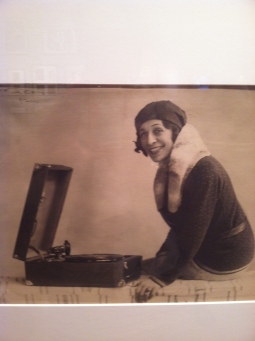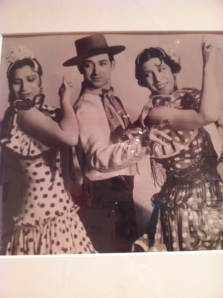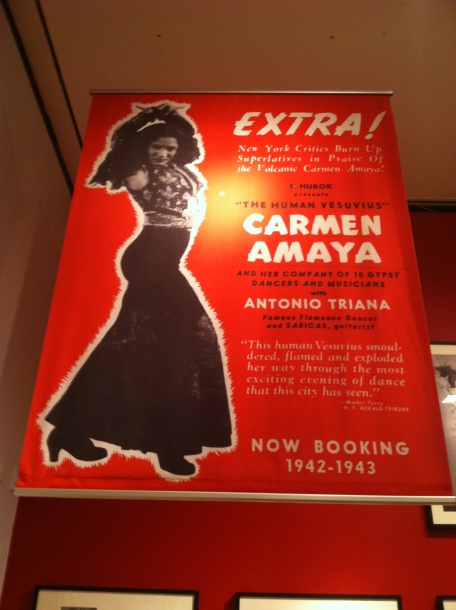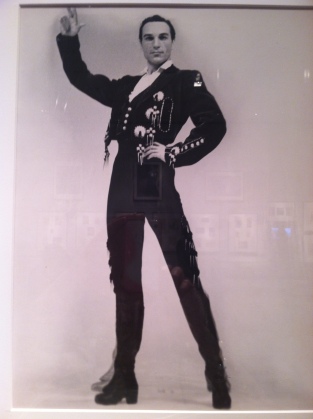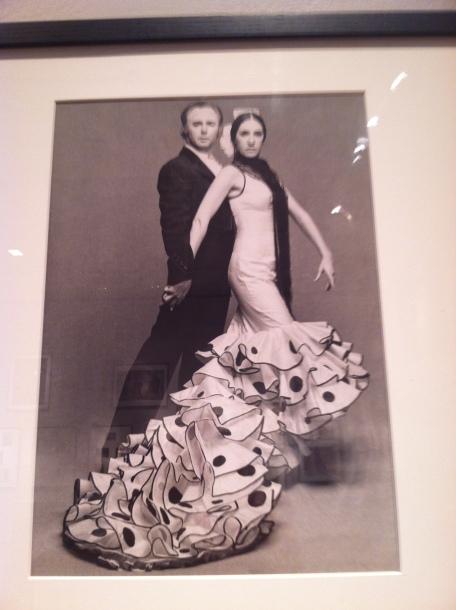With this new project of La nuit espagnole: Flamenco and the vanguard on my hands for this July at Between the Seas Festival in New York City, I am doing research into the fascinating world of flamenco dance. Lucky for me, the New York Library for the Performing Arts at Lincoln Center currently has the exhibition 100 years of Flamenco in New York at the Vincent Astor Gallery, located in the lower floor of the library. The exhibition opened on March 12 and runs through August of 2013. Curated by American dancer and choreographer Carlota Santana, the exhibition tells the great yarn of the first Spanish dancers that performed in NYC, the evolution of this art form in American soil, and the emerging American artists that delved in Spanish dance that went on to have careers, found their own companies and train new generations in this art form. Adding ingredients such as of jazz and tap dance, flamenco in NYC continues to evolve and change; the American school of Spanish dance is a living genre, as dynamic as the New Yorkers of all walks of life that continue to perform it. I visited the exhibit last Wednesday afternoon, and save for a couple of people that came in for a short while, I had the place to myself.
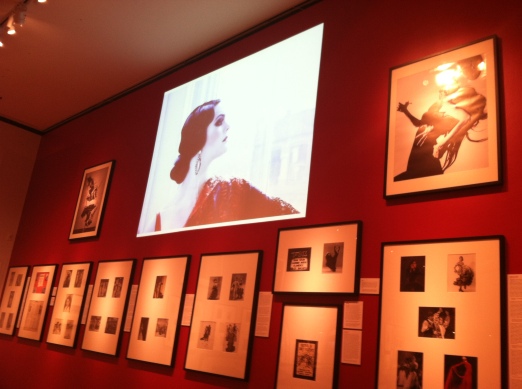
Main wall of the exhibition with large screen, which had different images that flashed, of past and current Flamenco dancers of New York City.
The exhibit starts its narration with the mid to late 19th century, detailing the first Spanish dancers to perform in New York City in the 1830’s and 1840’s. There is a an ongoing film of the first woman ever to be caught on film by Edison’s Vitascope in 1894, Carmencita the pearl of Seville, as well as engravings of Fanny Elssler, who danced for President Van Buren, and whose dance “La cachucha” stopped business at US Congress. Interspersed with programs, photographs and drawings, the story tells the story of these early performances that took place in theaters, beer halls. It became the craze in New York in the 1850’s.
 Interspersed with the photographs, there were programs and beautiful drawings and etchings of these early Spanish dancers. One of them was intriguingly enough Japanese. There were also pixs of these early performances, among them of a veritable battalion of Spanish dancers in toreador costumes. Many of these early performances took place in the old theater district of Herald Square, places like Niblo’s Pleasure Garden and the Eden Museum.
Interspersed with the photographs, there were programs and beautiful drawings and etchings of these early Spanish dancers. One of them was intriguingly enough Japanese. There were also pixs of these early performances, among them of a veritable battalion of Spanish dancers in toreador costumes. Many of these early performances took place in the old theater district of Herald Square, places like Niblo’s Pleasure Garden and the Eden Museum.
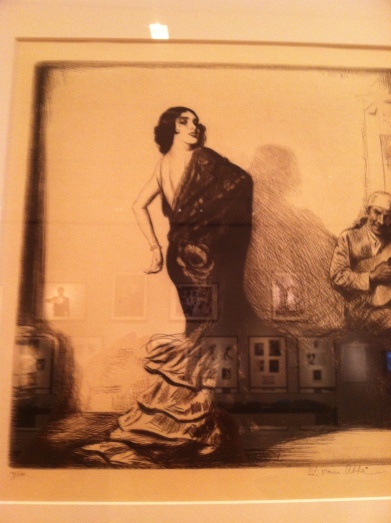 The waves of Spanish immigrants into New York City at this time, and with the founding of Spanish Benevolent Society on W. 14th, also provided a place for these recent New Yorkers to have a place for dance instruction for their children and the community. The Spanish Benevolent Society is still in existence and carries on the tradition for Flamenco dance, known here in NYC as “La Nacional”.
The waves of Spanish immigrants into New York City at this time, and with the founding of Spanish Benevolent Society on W. 14th, also provided a place for these recent New Yorkers to have a place for dance instruction for their children and the community. The Spanish Benevolent Society is still in existence and carries on the tradition for Flamenco dance, known here in NYC as “La Nacional”.
Moving into the years following the Spanish American War, we encounter Antonia Mercé “La Argentina”, Encarnación López “La Argentinita” and Vicente Escudero, all personalities that are part of the early Spanish avant-garde that I’m highlighting. The famous Man Ray photograph of Escudero was on the wall, as well as well known and more rare pixs of “La Argentina” and “La Argentinita” . There was a photograph of a special dinner hosted by Spanish intellectuals at Columbia University to honor “La Argentina”; among that group was a young Federico García Lorca, who was soon to write his famous “Poeta en Nueva York”, who took part in the festivities that evening, taking the opportunity to recite poems from his Romancero Gitano.
Encarnación López “La Argentinita” and her sister Pilar where also headliners in those years in New York City. There were fun shots of their show, some showing them simulating a “cat fight”. Both of these acts played in the cities most prestigious stages.
With the Spanish Civil War came the exile of a true blooded gypsy performer that took New York by storm, Carmen Amaya. Donning pants a la Marlene Dietrich, Amaya was a virtuoso, with furious foot work that dazzled. She was billed by her manager Sol Hurok as “The Human Vesuvios”. After Amaya, Spanish dance in America came to be seen exclusively as gypsy style Flamenco, sweeping Spanish classical dance styles to the sidelines. The Wild and unschooled Amaya was a contrast to the generation before her. She appeared in numerous movies in Hollywood.
The most interesting part of the exhibit begins shortly after this segment, detailing who were the first pioneer Americans in the 1940’s that took up this art, many of them immersing themselves and traveling to Spain. Vicente Escudero and “La Argentinita” did their part in discovering native talents in New York City, such Italian born José Greco, who went on to have his own company, touring for 40 years and training several generations of American dancers. One of his costume jackets is on display as well as various photographs. At one of the two ongoing film stations, Mr. Greco is interviewed, speaking of his immigrant background and of the multicultural environment of his childhood years in Brooklyn.
Other American stories emerged: a young Irish American dancer called Joan Fitzmaurice becomes the electrifying Maria Alba; Texas raised cowgirl, Russell Meriwether Hughes became a legendary Spanish and Indian dancer, author of books as well as a founder of her own academy in NYC, known as “La Meri”. I saw inspiring photographs of Nuyorican female dancers that also where part of the Flamenco scene in the 1960’s in the city. I was happy to see photographs of a young Jerane Michel, who was the choreographer of the Caprichos Boleros show I was involved with a few years ago, both in film as a castanet artist, and with her partners Mariano Parra, a half Andalusian, half Russian respected choreographer and teacher. True to New York’s heritage, the American wave of Spanish dancers became experts in the field, some of them writing books, forming their own companies and foundations, such as the Foundation for Ethnic Dance by the legendary Matteo and his partner Carola Goya,
The end of the exhibit show cased photographs of the flamenco dancers and companies that are performing currently in New York City, included is New York born Nelida Tirado, with whom I had done a song and dance performance for the Latin American Cultural Center in Queens, and is said to be one of the best flamenco performers in the city. Also featured is friend Rebeca Tomas and her company “A palo seco”, which has garnished rave reviews from The New York Times, and is part of La nuit espagnoles: Flamenco and the Spanish Vanguard:
Link to promo video of A palo seco, dancer and choreographer Rebeca Tomas
All in all a fascinating exhibition that I highly recommend for lovers of Spanish culture, dance and those interested in cultural history of New York City. The exhibit is free and a great way to spend the afternoon; for more information,
http://www.nypl.org/events/exhibitions/flamenco-100-years-flamenco-new-york
